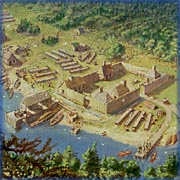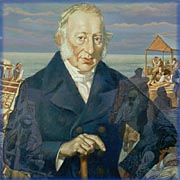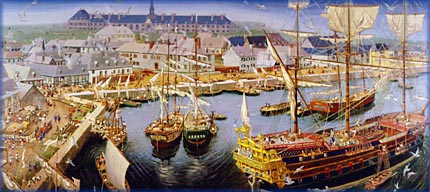|
In the seventeenth and eighteenth centuries, permanent
settlements were established along the coasts.
 nglish and French
monarchs intervened by granting concessions to aristocratic
entrepreneurs, and companies such as the London and Bristol
Company. The fishing proprietors were expected to attract
settlers to their colonies, but few succeeded. One of them,
Nicolas Denys, was granted a monopoly on trade and resources,
including the fishery, in an immense territory that extended
beyond the borders of Acadia. nglish and French
monarchs intervened by granting concessions to aristocratic
entrepreneurs, and companies such as the London and Bristol
Company. The fishing proprietors were expected to attract
settlers to their colonies, but few succeeded. One of them,
Nicolas Denys, was granted a monopoly on trade and resources,
including the fishery, in an immense territory that extended
beyond the borders of Acadia.
|

|

Nicolas Denys' first settlement at Saint-Pierre,
Cape Breton, in 1654
Detail from a painting by Lewis Parker
University College of Cape Breton Art Gallery, Sydney, Nova Scotia
(Reproduced with the permission of Lewis Parker, © 1982)
|
|
Nicolas Denys was given authorization to establish sedentary-fishery
operations in Acadia. He was appointed governor of the territory
extending from Cap des Rosiers, in the Gaspé Peninsula, to
Canso, in Acadia.
|
|
These entrepreneurs hired fishermen, farm workers and
tradespersons, who became the first European settlers in coastal
areas. By claiming the best bays, they challenged the seasonal
occupation of the beaches for drying cod and the principle of
freedom to fish.
|

|

Charles Robin at Arichat, 1760s
Detail from a painting by Lewis Parker
University College of Cape Breton Art Gallery, Sydney, Nova Scotia
(Reproduced with the permission of Lewis Parker, © 1982)
|
|
After 1765, fishermen from the island of Jersey came in large numbers
to the coasts frequented by the French. Charles Robin settled in Arichat,
on Madame Island (near Cape Breton), then moved to Chéticamp. He
founded Charles Robin and Company before moving to Paspébiac, on
the Gaspé Peninsula. In the nineteenth century, his firm became
the largest fishing company in Canada.
|

|
|
Louisbourg viewed from a warship, ca. 1728
Detail from a painting by Lewis Parker
University College of Cape Breton Art Gallery, Sydney, Nova Scotia
(Reproduced with the permission of Lewis Parker, © 1982)
|
|



